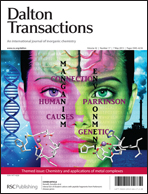New solid-phases for the binding, separation and extraction of perrhenate and pertechnetate (ReO4− and TcO4−) from water solutions have been developed from a selective molecular receptor. Host compounds being capable of encapsulating these oxoanions are of great interest. The azacryptand, containing two tripodal tetra-amine subunits covalently linked by p-xylyl spacers, is known to display high affinity for ReO4− and TcO4− in water. The syntheses of new solid phases, obtained by fixing the receptor on mesoporous silica MCM-41 and Amberlite CG50 supports, are here described. FT-IR, micro-Raman, elemental analysis (CHN), sorption isotherms, 29Si MAS NMR, and SEM/EDS were employed for solids characterisation. Promising performances were found for silica derivatives, for which the amount of the receptor fixed on silica ranged from 0.2 to 0.3 mmol g−1. The perrhenate sorption mechanism was investigated with the aim to select the conditions for application in batch and fixed bed column systems.

You have access to this article
 Please wait while we load your content...
Something went wrong. Try again?
Please wait while we load your content...
Something went wrong. Try again?


 Please wait while we load your content...
Please wait while we load your content...